Scotland: The Ultimate Holiday Guide
Scotland is a magical, magnificent country to make your home, or for a holiday retreat. Adventure or relaxation – whatever you seek, you’ll find it here. Our guide tells you why...
In this guide our writers take you to three spectacular regions...
The awesome Ayrshire coast
Caithness
Our 12–page special on Scotland covers three fascinating and varied areas – the dramatic scenery of the northwest lochs, the Ayrshire coast, and Caithness, in the northeast. There is a variety of wonderful places that are sure to tempt you to consider Scotland as a country for your new leisure home or park home, as our writers have discovered...
The spectacular west coast of Scotland
Spectacular walks across a remote landscape of mountains, lochs and glens. Plus some stunning beaches to cast your eye on...
Words and photos Felicity Martin
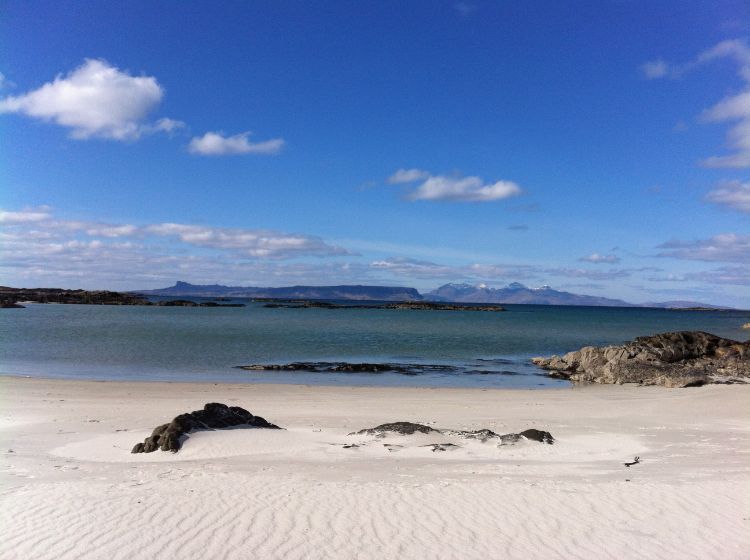
The further you venture north, on the west coast of Scotland, the more spectacular the scenery becomes.
If you’re considering buying a holiday home or a permanent park home in this wonderful region, you’ll want some ideas about how to make the most of your leisure time here. We’ve found plenty. 'Days out' ideas spread out before you, from discovering magnificent, dramatic scenery and hill walk challenges to much sedater rambles and wonderful roads to drive, taking you to amazing views, magical oak woods and tiny white sand beaches – places to visit again and again in this region that’s rich in history and wildlife.
Our expedition of discovery starts at the Corran Ferry, one of the few remaining mainland ferries. The ferry crosses Loch Linnhe, nine miles south of Fort William at the Corran Narrows. The ferry provides the most direct route to Ardgour, Morvern, Sunart, Moidart and Ardnamurchan, ancient districts in the far west, which – although attached to mainland Scotland – feel remote and less populated than many of the Hebridean islands.
.jpg)
It’s a swift crossing. We make for the Ardgour jetty, to meet friends for a hill walk. After two hours of puffing up a fairly precipitous slope of grass and rock we arrive at the trig point on Sgurr na h-Eanchainne, which is an incredible viewpoint.
Loch Linnhe stretches away to north and south, while serried ranks of mountain peaks recede into the distance on the other side. Below, a flat green triangle of land protrudes into the loch with the Corran Narrows at its tip. This, however, isn’t the highest point. We continue over gently undulating ground to Druim na Sgriodain, the top of the hill.
Loch Linnhe
Back at the bottom we enjoy a buffet at The Inn at Ardgour, which originated as a hostelry for drovers who brought their cattle this way to swim them over the narrows.
This one walk shows the brilliance of this area for anyone keen on walking. And there’s more. Much more, for exploring on foot and by car.
The next day we meander south down Loch Linnhe. The single-track B8043 runs through pretty scenery where green pastures and groves of trees line the shore with ochre-coloured hills rising inland.
We discover why the road has a 7.5-tonne weight limit when the hills thrust towards the loch. Suddenly we are driving along a narrow strip with only a low stone wall between us and a precipitous drop to the sea.
Loch Sunart
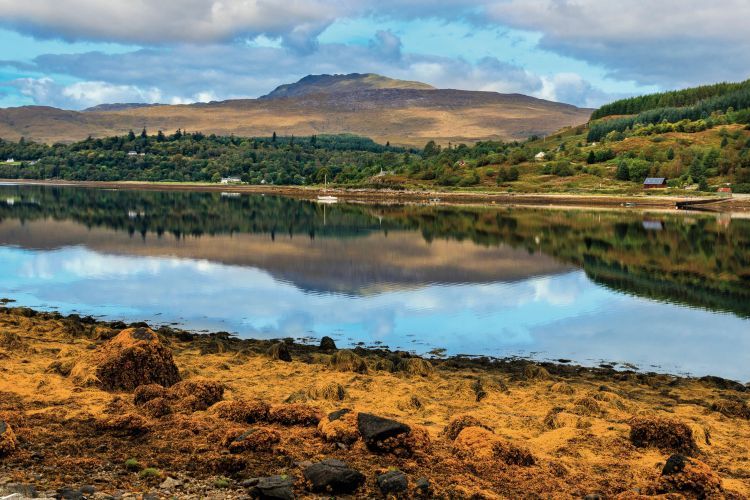
We turn north for Loch Sunart. Atlantic oak woods bound this sheltered sea loch winds deep inland, and it is a rich place for wildlife. We drive around the head of the loch to Strontian, a little village established in 1724 to house workers in lead mines that once employed 600 men. In 1790, experts discovered a new element in rocks mined here and named strontium after the village.
We spend the afternoon between the village and the disused mines in the woods of Ariundle, a National Nature Reserve. The oak trees were a valuable resource as pit props and to make charcoal for smelting lead, so they were regularly coppiced to encourage new stems. This was last done in 1850, so they are now all of a similar age.
We follow the three-mile way marked Ariundle Trail beside the Strontian River, where peaty water stains the boulders and gravel brownish-red. Then, rather than returning along the main track, we take the Woodland Walk, a narrow path that climbs into the oak wood.
This is a magical place with every tree and boulder covered in moss and lichens. The damp substrate they provide allows ferns to sprout from trunks and branches.
We continue west on the A861, which runs from the Corran Ferry in a big loop around Ardgour, Sunart and Moidart. The next section of single-track bobs and weaves along the rocky loch shore with woodland reducing visibility.
We pass the Forestry Commission car park for the walk to Garbh Eilean wildlife hide, which overlooks a rocky island in Loch Sunart. We’ve been there before and saw seals, ducks and a heronry, but not the otter we had hoped to see.
Eigg and Rum
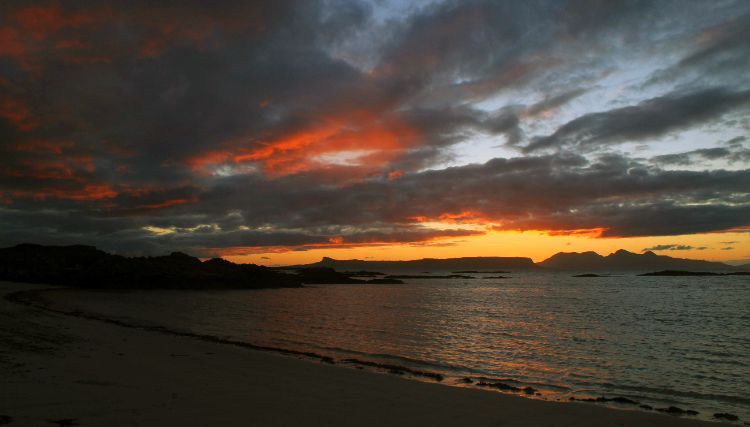
Native woodland rich in flora and fauna surrounds the burn and rough grazing extends upwards towards the summit of Beinn Resipol. This hill is renowned as offering one of the finest views in Scotland and is our target for tomorrow.
Our walk starts at Resipol and initially follows a path beside the burn. Higher up we tramp across boggy moorland and then climb steeply up a rocky little valley. The scenery is magnificent. Fingers of blue water thrust inland between ridges of tawny hills, while out at sea castellated islands float in a silvery haze.
Eigg shows its classic profile, while Rum rears up behind, its peaks looking formidable. The clear light gives us a vivid picture-postcard view of the coast. Our onward route turns north at Salen and we drive past pool-dimpled marshland, through Acharacle and over the bridge at the foot of Loch Shiel – scenery of which we had a bird's-eye-view from Beinn Resipol.
Loch Moidart
A little road leads to Castle Tioram, a romantic ruin on a tidal island. The tide is high, which means we can’t walk across, so we drive on over a low pass, to Loch Moidart. Here we see the remains of the Seven Men of Moidart, a line of beech trees planted, about 100 years after the event, in memory of the seven companions who landed with Bonnie Prince Charlie at Loch nan Uamh on 25 July 1745.
Sound of Arisaig
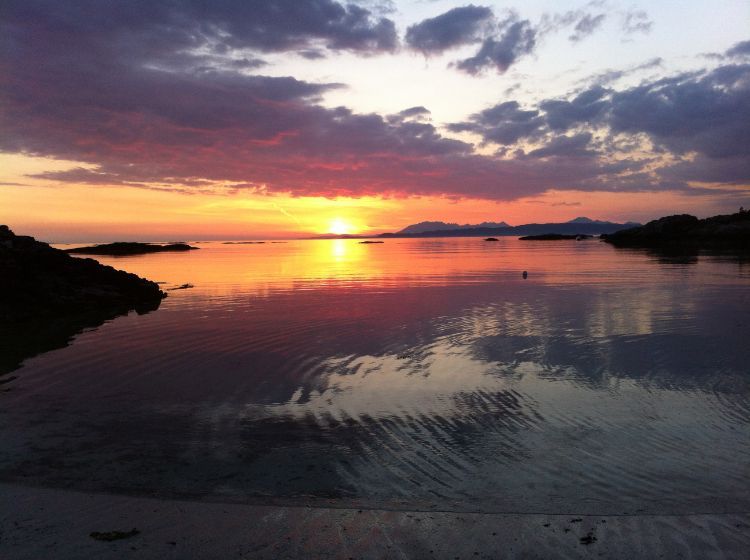
Another little pass, the Bealach Carach, lifts us up and over into Glen Uig, which leads down to the hamlet of Glenuig on the shore of a more open stretch of water. This is the Sound of Arisaig which divides around the Ardnish Peninsula into Lochailort and Loch nan Uamh.
Along the shore from Glenuig, little islets guard white sand beaches and vivid green salt marshes – and provide sheltered yacht moorings.
Glenfinnan
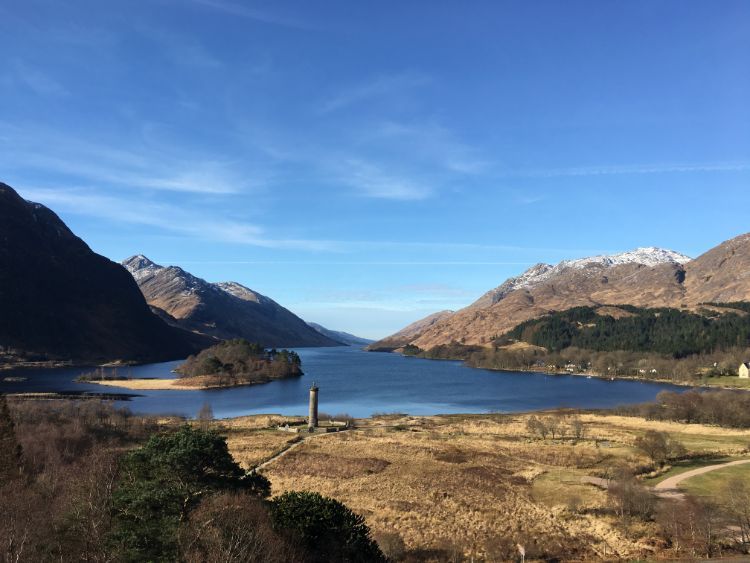
Our route now takes us to Loch Ailort, then eastwards to Glenfinnan at the head of Loch Shiel. The much-photographed Glenfinnan Viaduct is here and the Glenfinnan Monument nearby – a columnar stone tower erected in 1815 to mark the spot where Bonnie Prince Charlie came to rally support after travelling around the coast.
Hundreds of clansmen trooped to meet him and so began his challenge for the throne and the start of the second Jacobite rebellion, which ended at Culloden. It’s a bit of a climb to the Glenfinnan Viewpoint but definitely worth it for the views down over the monument with the loch behind Glenfinnan. Along the shore from Glenuig, little inlets guard white sand beaches and vivid green salt marshes.
Fort William
We drive on east and stop in Fort William to enjoy coffee and cake. We stroll along the waterfront. In our days of exploring the west coast we had discovered brilliant hill walks and easier rambles around magnificent scenery, rich in history and wildlife, in a region that we can strongly recommend.
The awesome Ayrshire coast
With history, sculpture, beaches, castles, walking and cycling, you’ll never be short of things to discover along the Ayrshire coast. Plus, there’s the enchanting island of Arran that you can explore again and again
Words and photos Gayle Ripper
Ayrshire and Arran
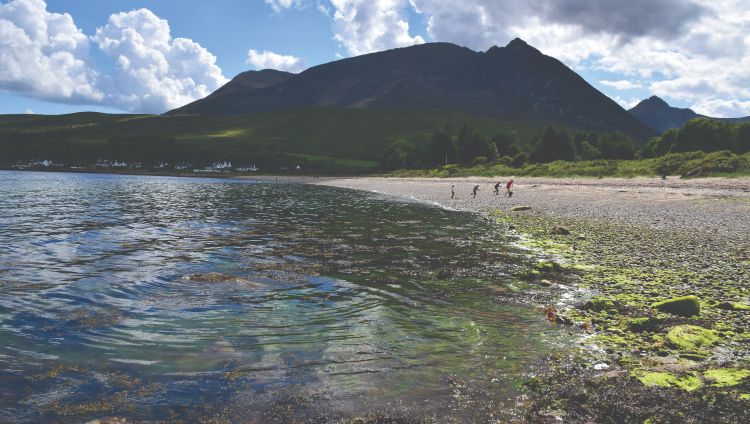
Ayrshire may not be as famous as Loch Lomond or the Highlands but it’s a brilliant place to choose for a holiday home or park home. This county is on the shores of the Firth of Clyde. Its principal towns include Ayr, Kilmarnock and Irvine.
Growing up in Glasgow, my early family holidays were at seaside towns in Ayrshire. Today, I recommend Troon, Irvine and particularly Largs, as I discovered when I took my family to explore areas you may like to consider for your own place in this region.
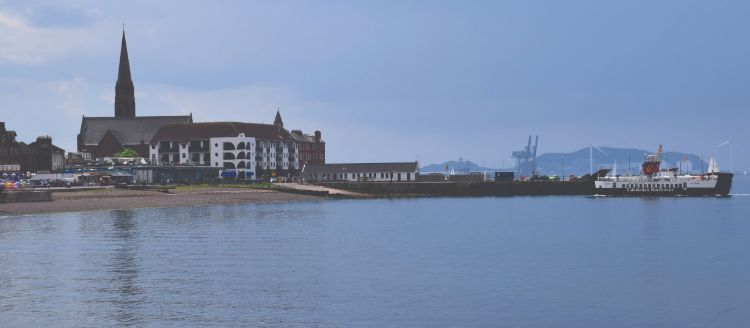
We began our tour with a visit to Robert Burns’ birthplace in Alloway. We wandered around the charming gardens before making our way over the road to Poet’s Path which leads to the museum. The sculptures along the way are great fun. We particularly liked one of a giant granite haggis!
Next on my list of places to recommend is the nearby ‘Auld Brig’, otherwise known as Brig o’ Doon, the original fifteenth century cobblestone bridge over the River Doon, which Tam o’Shanter crossed on horseback, fleeing from the witches and warlocks who couldn’t follow him across the water.
Culzean Castle and Country Park is another interesting place. With gardens, follies, beaches, woods, trails and adventure playgrounds, there is plenty to explore. The weather prevented us from doing much exploring outdoors but this proved that, even on dismal days, Culzean (pronounced cull-ane) is worthy of many visits.
Dumfries House is a little-known gem of a place. The house itself is impressive but the highlight for families will be the Engineering Playground, discovering water forces, dams, pressure, and how it affects movement. There’s also a collection of Chippendale furniture. You could easily spend a day here.
With history, sculpture, beaches, castles, walking and cycling, you’ll never be short of things to discover long the Ayrshire coast. Plus, there’s the enchanting island of Arran that you can explore again and again exploring some 2,000 acres of this stunning estate which includes Avenue Bridge, a three-arch bridge adorned with obelisks, an icehouse, a coach building, the ruins of Terringzean Castle and a temple.
The Beaches
Troon Beach is a good choice for pet owners as the beach is dog-friendly. The beach runs alongside a charming little town and, being famous for golf, there is no shortage of top quality courses.
Ayr Beach runs alongside a busy, bustling town with the usual high street chain shops plus bars, restaurants and takeaways.
Isle of Arran
The Isle of Arran was an excitedly expected part of our trip and it didn’t disappoint us. We travelled on the ferry to Brodick as foot passengers as our last-minute plan meant that there was no space for the car.
The bus service is great here, so being without a car isn’t a problem. One leader from Lochranza Activity Centre met us from a bus stop and led us along a pretty walk across stepping stones, past a stunning beach and through a wooded area until we reached the cliff side.
If you are looking for brilliant family days out, this centre is a place to make for. Rope ladder challenges, gorge walking, kayaking and abseiling are on offer. And the walk to the clifftop gives you a stunning view.
Our time on Arran convinced me to add it to my ‘I could live here’ list. Often described as all of Scotland in miniature, it’s easy to see why. Low population, stunning beaches populated only by us on a warm June day, lochs, glens, forests mountains, spectacular scenery, wildlife that includes birds of prey, deer and red squirrels, forests, mountains and glens – this is a special place.
The Kelpies

Matt hew, my middle son, adores art and sculptures. The Kelpies are one that he had been desperate to visit for some time so we made sure we included it in our plans. At 98 feet tall, the dramatic structure of the heads of two horses is an awesome sight and, when illuminated, will take your breath away.
The Kelpies highlight the importance of the horses in industry and economy, pulling wagons and ploughs, barges and coal ships that shaped the layout of the area.
Dunure Harbour
Dunure harbour and village is notable for its ruined clifftop medieval castle. About five miles outside Ayr, it’s great for dog walking and the kids enjoyed clambering over the rocks plus jumping onto the soft sand below before wandering around the harbour.
Largs
Largs is a great place for cycling and walking. This place is famed for a battle in 1263 when the Vikings, attempting to land from a fleet of longboats, were repulsed by the army of Alexander III. The Viking heritage is celebrated at Vikingar!, a Viking-themed attraction.
Largs is also home to the famous Nardini’s ice cream shop, an art deco ice cream parlour and fine dining restaurant.
Isle of Cumbrae
Close to Largs lies the Isle of Cumbrae, a mile offshore, to which a regular ferry service makes trips. To the south of the town, a stroll along the pebbly shoreline towards the harbour provides lovely coastal views.
Kelburn Castle and Country Centre
Near from Largs lies Kelburn Castle and Country Centre. The paint of the outer walls of this thirteenth-century castle carry bright and bold eye-catching designs by Brazilian artists. You can wander through the woodland glen, a tranquil place of waterfalls and deep gorges; a stunning walk.
Glasgow
On our final day, we came to Glasgow to visit Kelvingrove Art Gallery. Matthew had read about an exhibition of Frank Quitely, a comic artist, and was keen to look at his work. There are some extraordinary works of art here including the Floating Heads by Sophie Cave.
This is a spectacular art gallery and definitely worth visiting.
Whitelee Windfarm
Whitelee Windfarm, the UK’s largest onshore wind farm is on Eaglesham Moor, 20 minutes from central Glasgow. It’s a beautiful walk among 215 gigantic silent turbines, over hills and alongside small lochs. There are different trails and routes to explore, covering over 80 miles.
Caithness
Northeast Scotland is a remote land of vivid light, big skies and spectacular geology. Tempted to buy a holiday home or park home here? We find loads of reasons you’ll love this region
Words and photos Carol Kubicki
.jpg)
The county of Caithness, in northeast Scotland, is ideal for hikers, birdwatchers and history-lovers. This remote land has big skies, vivid light, endless moorland and unrivalled coast.
Around every corner they have preserved the stories of people in an exceptional landscape. We disembarked from the Orkney ferry, picking up the single-track road towards Dunnet Head.
In the Devonian period (around 400 million years ago), Caithness was mountainous. The Old Red Sandstone formed during this period, leaving layers of rock that split easily into flagstones. Where these sandstones meet the sea, the layered structure creates sheer cliffs and stacks perfect for nesting seabirds.
Caithness
We reach the rocky promontory of Dunnet Head and walk to the cliffs. We saw puffins, kittiwakes, fulmars and a seal bobbing in the waves. We walk along the coast by the lighthouse to a viewpoint; sandstone cliffs to one side, moorland dotted with lochs to the other. This was Caithness in miniature.
Following the coast to pretty Ham Bay, we explore the old, four-storey corn mill and mill pond among fragrant meadowsweet. By Gill’s Bay we watch an Arctic skua fly along the shore while looking out to the abandoned island of Stroma, a few miles off the coast.
The Old Red Sandstone makes another dramatic appearance at Duncansby Head. The walk here is stunning and this wild coast contrasts with the commercialism of John O’Groats. With ever-changing views, precipitous cliffs, Thirle Door sea arch and two jagged cone-shaped sea stacks, it is breathtaking.
Loch of Yarrows
Loch of Yarrows has a short archaeological trail that includes two Neolithic burial cairns. These cairns, high above the loch, were used for burials for over 1,000 years.
Whereas archaeologists have some idea how burial cairns were used, the unique Caithness stone rows that the Bronze Age (4,000 years ago) people left are a mystery. Over 170 stones remain. They are mostly knee-high and fan out in 23 rows with a central axis.
Nearby, on a low rise above Loch Stemster, is another setting of Bronze Age standing stones. Achavanich is a rare U-shape of 35 Caithness flagstones, all around the height of a person.
Morven
A single-track road out of Dunbeath ends at a small parking area. From here there is a memorable six mile return walk along the valley track into remote Caithness flow country, with the magnificent pyramidal peak of Morven before you.
If you decide to ascend Morven (2,316 feet) because it is the highest mountain in Caithness, be warned; it is a long and steep climb with bogs, scree and no marked path. The views from the summit over moorland, valleys and the bulk of Ben Hope 30 miles away are stunning.
Caithness is peppered with brochs – impressive Iron Age fortified round towers with a double wall enclosing stairs. Near Nybster we found the remains of a broch and, below, a fishing hut with a Caithness flagstone roof. Beside the site is a weathered ornate monument decorated with gargoyles.
Sutherland
A few days later – and further south in Sutherland – we came upon Carn Liath Broch, again with a clifftop position. This well-preserved and remarkable broch gives a good sense of the sophisticated construction.
At the attractive harbour of Helmsdale, we ate in a pub and wandered the harbour walls watching a seal bobbing in the water.
Whaligoe Steps
Whaligoe Steps has been on our list for some time, and we grabbed the chance to explore this picturesque anchorage. Built in the 1700s, fishing folk used these steep steps. They say there are 365 steps built into the cliff; I didn’t count them as I was too busy enjoying the views!
Loch Muick
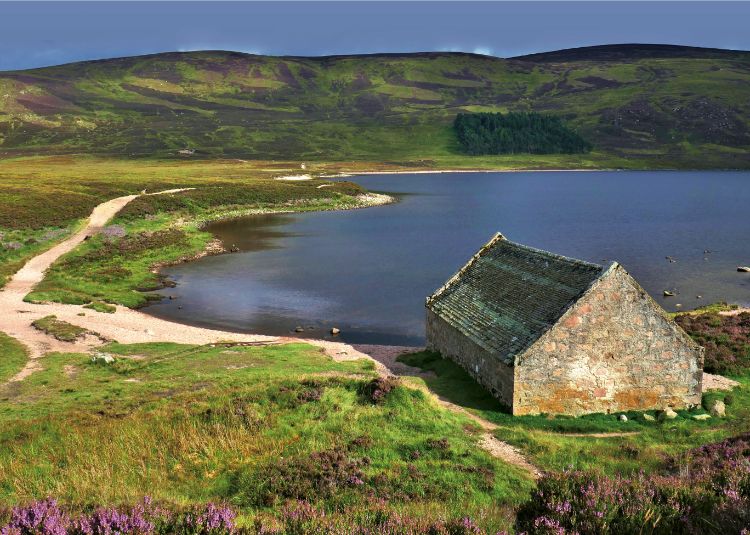
You can walk along the track by the alluring and remote Loch Muick. With a boathouse on the loch, Scots pine and heather-clad hills, this is 'shortbread-tin Scotland’. We hiked up Lochnagar, a popular (but tough!) climb that isn’t for the unprepared, even in glorious weather. We were lucky to spot a plump ptarmigan on the summit ridge and then descended to the loch by the lively waterfalls of Glas Allt.
Loch Earn
We sat on the shore as the sun dipped behind the hills opposite and reflected on the joys of this magnificent region, with so much to explore again and again.








Recent Updates
Park home surveys: all you need to know
For buyers of pre-owned park homes, a survey is vital to make sure the property you're buying is structurally sound and has been properly valued - ...
Selling a park home: all you need to know
Selling your park home is rarely an easy decision, so make the process easier with our guide to managing the ...
Park home energy: all you need to know
Make your park home more energy efficient with these tips, helping to save you money and be more ...
Park home refurbishment: all you need to know
Maintaining the condition of your park home, from its bathroom fittings to the condition of its chassis, is ...
Living in a park home: all you need to know
What's it really like to live in a park home? What are the pros and cons, the fees involved and the most ...
Forest retreats: all you need to know
Relax and immerse yourself in nature with a holiday home forest retreat, fusing the community and perks of a ...
Our guide to holiday homes by the sea
If you're interested in buying a holiday home, chances are you're going to look at a coastal holiday park – ...
Holiday homes for all budgets: our guide to mid-level holiday homes
If you are looking for a quality holiday home but don’t want to buy at the top end, the good news is that you ...
Holiday homes for all budgets: our guide to affordable holiday homes
Buying a holiday home on a budget may initially seem a daunting prospect – but there is a lot of choice out ...
Park and holiday home decking: everything you need to know
Decking is a fantastic addition to your holiday home, helping you to enjoy a more outdoorsy lifestyle ...
Other Articles
Park and holiday home finance: everything you need to know
Looking to buy a park or holiday home on finance? While holiday home mortgages are off the table, you can find great finance deals on park and ...
Park home part exchange: what you need to know
Our essential guide for anyone thinking of buying a residential park home using part exchange, including ...
Solar panels for park homes: our advice
If you're considering installing solar panels on your park home, you're far from alone – this growing trend ...
Buying a park home: 10 things to consider
Buying a home on a residential park is a huge and exciting step. Here is our comprehensive guide to making ...
Park home and holiday home chassis: everything you need to know
The chassis underpins the structural integrity of a park home or holiday home. This guide to the essentials ...
Holiday home and park home insurance: your complete guide
Specialist insurance is key to finding the cover most suitable for both park and holiday homes. Read our ...
Park home maintenance advice
Your park home chassis, roof and guttering need to be kept in top condition and older homes may benefit from ...
Park home construction: everything you need to know
A complete guide to park homes, including how and what they are made of ...
Park home paint: how to keep your park home in pristine condition
Our guide to painting your park home and keeping it looking its best ...
A top choice of holiday homes for sale
For your perfect home away from home, take a look at this great selection ...